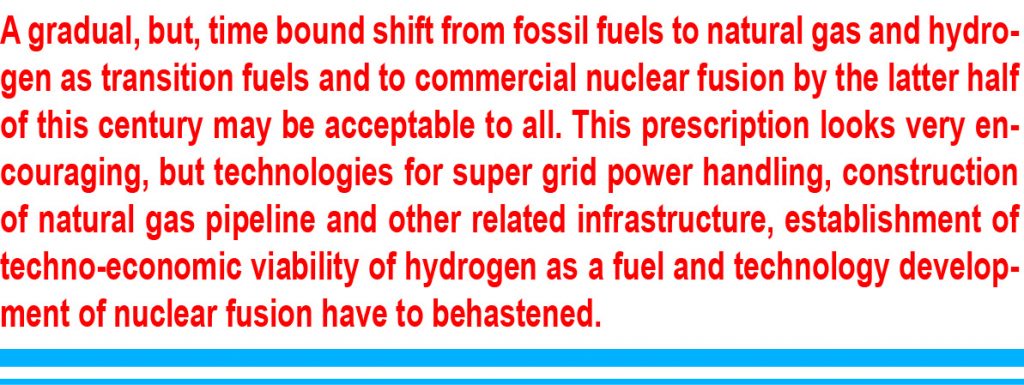Introduction
Energy is an essential input for improvement of the quality of life in modern times. Apart from unequal distribution across regions, today, we understand that the current mode of energy production, distribution and usage are no longer sustainable on account of its huge carbon intensity and consequential environmental and climate related hazards. UN SDG 7 aims to address the issue by ensuring that everyone has access to affordable, reliable, and modern energy services by the year 2030 and at the same time enhance energy efficiency and develop more and more renewable energy resources. Now-a days, over three quarters of the increase in energy consumption come from developing regions. According to the latest BP Statistical Review of World Energy, in 2019, renewable resources which include wind, water, solar, biomass and geothermal energy constituted 5 percent of the global primary energy consumption- an increase of 0.5 percent from 2018.
 Both the 2030 Agenda for Sustainable Development and the Paris Agreement on Climate Change recognise that the world is currently not on track to meet the Sustainable Development Goals including SDG 7 on energy or to keep global temperature rise this century below 1.5°C above pre-industrial levels and therefore, the global energy transformation must be accelerated to achieve the goals. At the same time, there is also a deep concern that over three billionpeople still lack access to clean energy. In order to overcome these problems, the power sector needs a whole lot of decarbonization. The traditional centralized organization of the power system has to be transformed to distributed and renewable generation. Smart grids, distributed photovoltaic (PV) and other renewable sources and digital technologies will be at the centre of this transformation.
Both the 2030 Agenda for Sustainable Development and the Paris Agreement on Climate Change recognise that the world is currently not on track to meet the Sustainable Development Goals including SDG 7 on energy or to keep global temperature rise this century below 1.5°C above pre-industrial levels and therefore, the global energy transformation must be accelerated to achieve the goals. At the same time, there is also a deep concern that over three billionpeople still lack access to clean energy. In order to overcome these problems, the power sector needs a whole lot of decarbonization. The traditional centralized organization of the power system has to be transformed to distributed and renewable generation. Smart grids, distributed photovoltaic (PV) and other renewable sources and digital technologies will be at the centre of this transformation.
Trends in Energy Consumption
The International Renewable Energy Agency (IRENA) defines the pathway to energy transition through a transformation of the global energy consumption from fossil-based to zero- carbon by the second half of this century. At the heart of the transition are the need to reduce energy-related CO2 emissions to limit climate change, decarbonisation of the energy sector incorporating more and more renewable resourcesto it and increasing energy efficiency measures across all usersegments.
The history of energy consumption of people clearly indicates a change in energy mix with time-wood to charcoal and coal to oil and gas to renewables. The approach towards change in energy mix depends mostly on the political ideology of nations. Some are for a transition from fossil fuels to low carbon resources at a slow pace citing the need to manage the transition and further establish the credibility of renewables. Others are more liberal and progressive advocating for a faster transition on account of the advancing climate impacts. At the policy level, both propose to invigorate the slow pace and clamp down the fast pace by setting time bound targets for the transition counting on the historical experiences and deliver adequate, cost effective, safe and environment friendly energy solutions for future. Truly, we need a pragmatic policy and approach for energy transition quickly enough so as not to inflict heavy damages to the environment or too slow so that the consequencesare irreversible.
transition and further establish the credibility of renewables. Others are more liberal and progressive advocating for a faster transition on account of the advancing climate impacts. At the policy level, both propose to invigorate the slow pace and clamp down the fast pace by setting time bound targets for the transition counting on the historical experiences and deliver adequate, cost effective, safe and environment friendly energy solutions for future. Truly, we need a pragmatic policy and approach for energy transition quickly enough so as not to inflict heavy damages to the environment or too slow so that the consequencesare irreversible.
From Fossil Fuels to Cleaner Sources of Energy
The unsustainability of present-day energy production emphasizes the need for a gradual decline in the use of fossil fuels,naturalgasto occupy the interim stage and pave the way for a carbon neutral energy mix. Though it is accepted well among mainstream scientists that the climate is changing all over the globe, there is no consensus that it is mostly contributed by anthropogenic emissions. Rather than emissions some regard it due to growing population and its energy and other resources related pressure and hold that the variations are nothing alarming and they are only a natural variation or average when considered in totality. Due to certain industrial accidents occurred in the past, public sentiment is against nuclear energy and favour solar and other renewables over fossil fuels. The gradual reduction in the cost of generation of solar power and countries like India going for massive solar power projects indeed, is encouraging. There are certain concerns in promoting biofuels for reducing emission of greenhouse gases even as a transition alternative. The socio-economic and environmental dimensions of climate change are to be clearly unearthed and well brought out before narrowing down on a select fuel or energy resource.
While the COP21: Paris climate agreement depends mostly on commitment from national governments, the Trump administration’s negative approach citing US interests have slowed down the momentum of advancement towards sustainable use of energy. With the US retracting on the environmental agenda being pursued by the previous presidency, it is clear that business interests prevail over everything. The incoming Biden administration in the US is believed to have a perception to positively contribute to the global sustainability agenda. Here we also shall not forget the collaborative efforts under the Oil & Gas Climate Initiative (OGCI) of the oil and gas industry majors. Fast tracking e-mobility, producing green ammonia from water and renewable power, increasing digitization of manufacturing sectors, harnessing utmost energy efficiency, full scale recycle and reuse -all now-a-days, have seen a renewed effort and accelerated thrust.
Future Composition of Energy Mix
Post COVID-19, our ways of doing things and our outlook towards global issues and concerns are undergoing changes more than ever before. We have to define our future energy needs and decide on the kind of energy mix that is capable of meeting the needs with a positive impact on the environment. The current technologies supporting this requirement are low-carbon energy sources (wind, solar power, hydropower, biomass, nuclear, and geothermal), electricity storage solutions, smart grids, network interconnections, sector coupling, demand-side management and carbon capture sequestration and storage.
The energy transition of any society is a long-drawn-out process involving multiple stakeholders. During anytime the energy mix changed in the past, the interplay of such forces is evident. A gradual, but, time bound shift from fossil fuels to natural gas and hydrogen as transition fuels and to commercial nuclear fusion by the latter half of this century may be acceptable to all. This prescription looks very encouraging, but technologies for super grid power handling, construction of natural gas pipeline and other related infrastructure, establishment of techno-economic viability of hydrogen as a fuel and technology development of nuclear fusion have to be hastened.
 India is currently using only 6 per cent of the world’s primary energy and the country’s per- capita consumption of energy is still one-third of the global average. Globally, India is the third largest consumer of energy resources, next only to China and the US . It is also the third largest crude oil importer and the fourth largest liquified natural gas importer in the world. India’s energy consumption is projected to grow at 2.5 to 3 percent per annum up to 2050, faster than all major economies and its share of total global primary energy demand is said to more than double by 2050 driven by economic growth. In this respect the Modi government has charted out an action plan to shift energy consumption mostly towards natural gas so that by 2040 the share of natural gas in the country’s primary energy mix to go up to 15 percent from the current 6 percent. According to BP Energy outlook 2020, under a business-as-usual scenario, the share of coal in India’s primary energy consumption is to decline to 40 percent from 56 percent, oil to drop to 22 percent from 30 percent, natural gas to increase to 10 percent from 6.2 percent, nuclear to increase to 3.2 percent from 1 percent and renewables to increase to22 percent from
India is currently using only 6 per cent of the world’s primary energy and the country’s per- capita consumption of energy is still one-third of the global average. Globally, India is the third largest consumer of energy resources, next only to China and the US . It is also the third largest crude oil importer and the fourth largest liquified natural gas importer in the world. India’s energy consumption is projected to grow at 2.5 to 3 percent per annum up to 2050, faster than all major economies and its share of total global primary energy demand is said to more than double by 2050 driven by economic growth. In this respect the Modi government has charted out an action plan to shift energy consumption mostly towards natural gas so that by 2040 the share of natural gas in the country’s primary energy mix to go up to 15 percent from the current 6 percent. According to BP Energy outlook 2020, under a business-as-usual scenario, the share of coal in India’s primary energy consumption is to decline to 40 percent from 56 percent, oil to drop to 22 percent from 30 percent, natural gas to increase to 10 percent from 6.2 percent, nuclear to increase to 3.2 percent from 1 percent and renewables to increase to22 percent from
3.4 percent from the consumption recorded in 2018. All the above, together with the efforts of the government and industry towards a higher order of energy use efficiency indicate substantial reduction in emissions from the present and a gradual transition to a low carbon future for the country.
*formerly Secretary to Chief Minister, Kerala and Chairman, Public Sector Restructuring & Audit Board, Kerala State. India + 91 9447154540, www.drmpsukumarannair.com

































